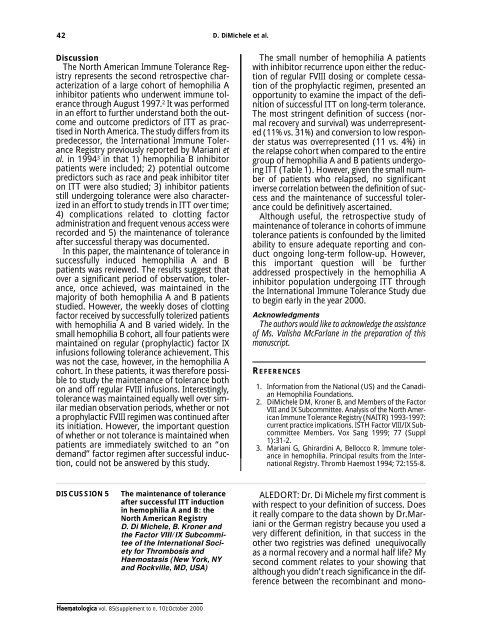Haematologica 2000;85:supplement to no. 10 - Supplements ...
Haematologica 2000;85:supplement to no. 10 - Supplements ...
Haematologica 2000;85:supplement to no. 10 - Supplements ...
Create successful ePaper yourself
Turn your PDF publications into a flip-book with our unique Google optimized e-Paper software.
42<br />
D. DiMichele et al.<br />
Discussion<br />
The North American Immune Tolerance Registry<br />
represents the second retrospective characterization<br />
of a large cohort of hemophilia A<br />
inhibi<strong>to</strong>r patients who underwent immune <strong>to</strong>lerance<br />
through August 1997. 2 It was performed<br />
in an effort <strong>to</strong> further understand both the outcome<br />
and outcome predic<strong>to</strong>rs of ITT as practised<br />
in North America. The study differs from its<br />
predecessor, the International Immune Tolerance<br />
Registry previously reported by Mariani et<br />
al. in 1994 3 in that 1) hemophilia B inhibi<strong>to</strong>r<br />
patients were included; 2) potential outcome<br />
predic<strong>to</strong>rs such as race and peak inhibi<strong>to</strong>r titer<br />
on ITT were also studied; 3) inhibi<strong>to</strong>r patients<br />
still undergoing <strong>to</strong>lerance were also characterized<br />
in an effort <strong>to</strong> study trends in ITT over time;<br />
4) complications related <strong>to</strong> clotting fac<strong>to</strong>r<br />
administration and frequent ve<strong>no</strong>us access were<br />
recorded and 5) the maintenance of <strong>to</strong>lerance<br />
after successful therapy was documented.<br />
In this paper, the maintenance of <strong>to</strong>lerance in<br />
successfully induced hemophilia A and B<br />
patients was reviewed. The results suggest that<br />
over a significant period of observation, <strong>to</strong>lerance,<br />
once achieved, was maintained in the<br />
majority of both hemophilia A and B patients<br />
studied. However, the weekly doses of clotting<br />
fac<strong>to</strong>r received by successfully <strong>to</strong>lerized patients<br />
with hemophilia A and B varied widely. In the<br />
small hemophilia B cohort, all four patients were<br />
maintained on regular (prophylactic) fac<strong>to</strong>r IX<br />
infusions following <strong>to</strong>lerance achievement. This<br />
was <strong>no</strong>t the case, however, in the hemophilia A<br />
cohort. In these patients, it was therefore possible<br />
<strong>to</strong> study the maintenance of <strong>to</strong>lerance both<br />
on and off regular FVIII infusions. Interestingly,<br />
<strong>to</strong>lerance was maintained equally well over similar<br />
median observation periods, whether or <strong>no</strong>t<br />
a prophylactic FVIII regimen was continued after<br />
its initiation. However, the important question<br />
of whether or <strong>no</strong>t <strong>to</strong>lerance is maintained when<br />
patients are immediately switched <strong>to</strong> an “on<br />
demand” fac<strong>to</strong>r regimen after successful induction,<br />
could <strong>no</strong>t be answered by this study.<br />
The small number of hemophilia A patients<br />
with inhibi<strong>to</strong>r recurrence upon either the reduction<br />
of regular FVIII dosing or complete cessation<br />
of the prophylactic regimen, presented an<br />
opportunity <strong>to</strong> examine the impact of the definition<br />
of successful ITT on long-term <strong>to</strong>lerance.<br />
The most stringent definition of success (<strong>no</strong>rmal<br />
recovery and survival) was underrepresented<br />
(11% vs. 31%) and conversion <strong>to</strong> low responder<br />
status was overrepresented (11 vs. 4%) in<br />
the relapse cohort when compared <strong>to</strong> the entire<br />
group of hemophilia A and B patients undergoing<br />
ITT (Table 1). However, given the small number<br />
of patients who relapsed, <strong>no</strong> significant<br />
inverse correlation between the definition of success<br />
and the maintenance of successful <strong>to</strong>lerance<br />
could be definitively ascertained.<br />
Although useful, the retrospective study of<br />
maintenance of <strong>to</strong>lerance in cohorts of immune<br />
<strong>to</strong>lerance patients is confounded by the limited<br />
ability <strong>to</strong> ensure adequate reporting and conduct<br />
ongoing long-term follow-up. However,<br />
this important question will be further<br />
addressed prospectively in the hemophilia A<br />
inhibi<strong>to</strong>r population undergoing ITT through<br />
the International Immune Tolerance Study due<br />
<strong>to</strong> begin early in the year <strong>2000</strong>.<br />
Ack<strong>no</strong>wledgments<br />
The authors would like <strong>to</strong> ack<strong>no</strong>wledge the assistance<br />
of Ms. Valisha McFarlane in the preparation of this<br />
manuscript.<br />
REFERENCES<br />
1. Information from the National (US) and the Canadian<br />
Hemophilia Foundations.<br />
2. DiMichele DM, Kroner B, and Members of the Fac<strong>to</strong>r<br />
VIII and IX Subcommittee. Analysis of the North American<br />
Immune Tolerance Registry (NAITR) 1993-1997:<br />
current practice implications. ISTH Fac<strong>to</strong>r VIII/IX Subcommittee<br />
Members. Vox Sang 1999; 77 (Suppl<br />
1):31-2.<br />
3. Mariani G, Ghirardini A, Bellocco R. Immune <strong>to</strong>lerance<br />
in hemophilia. Principal results from the International<br />
Registry. Thromb Haemost 1994; 72:155-8.<br />
DISCUSSION 5<br />
The maintenance of <strong>to</strong>lerance<br />
after successful ITT induction<br />
in hemophilia A and B: the<br />
North American Registry<br />
D. Di Michele, B. Kroner and<br />
the Fac<strong>to</strong>r VIII/IX Subcommitee<br />
of the International Society<br />
for Thrombosis and<br />
Haemostasis (New York, NY<br />
and Rockville, MD, USA)<br />
ALEDORT: Dr. Di Michele my first comment is<br />
with respect <strong>to</strong> your definition of success. Does<br />
it really compare <strong>to</strong> the data shown by Dr.Mariani<br />
or the German registry because you used a<br />
very different definition, in that success in the<br />
other two registries was defined unequivocally<br />
as a <strong>no</strong>rmal recovery and a <strong>no</strong>rmal half life My<br />
second comment relates <strong>to</strong> your showing that<br />
although you didn’t reach significance in the difference<br />
between the recombinant and mo<strong>no</strong>-<br />
<strong>Haema<strong>to</strong>logica</strong> vol. <strong>85</strong>(<strong>supplement</strong> <strong>to</strong> n. <strong>10</strong>):Oc<strong>to</strong>ber <strong>2000</strong>
















